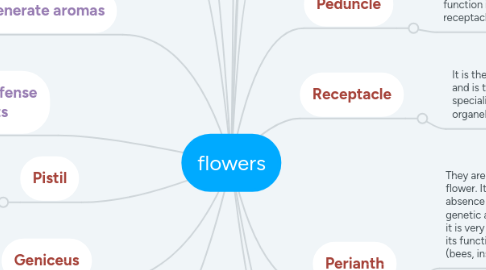flowers
von Valentina Ardila Escobar


1. Characteristics of the flowers
2. Striking structure or colors
2.1. The flowers are brightly colored to attract pollinating agents, such as bees or butterflies. The distribution of its petals also fulfills this function.
3. Produce nectar
3.1. Flowers also generate a substance called nectar, which works as a kind of "hook" to attract bees, butterflies, and other types of pollinators. By perching on the flower to search for nectar, pollen attaches to them and travels to other plants.
4. They generate aromas
4.1. Many floral species generate pleasant aromas for human smell, such as roses or lavender
5. They can act as a defense mechanism for plants
5.1. Some plants have flowers that function as a defense against herbivorous animals
6. Pistil
6.1. It is a tubular-shaped element that contains the female reproductive system of the flower.
7. Geniceus
7.1. It is the female reproductive system, and in turn is made up of the stigma (upper part of the pistil), the pollen tube that is the upper part of the style (where the pollen goes down), the ovaries, and the ovules
8. Androecium
8.1. It is the male reproductive system and is made up of the stamen, which is the organ that produces pollen, the anthers, the part of the flower where pollen is produced and which in turn is supported by the filaments, and teak, where pollen production is saved.
9. Pollination
9.1. It is the displacement of the pollen grain from the anthers to the top of the pistil
9.1.1. Pollination, in turn, can be of two types
9.2. Direct pollination: the passage of pollen to stigma is carried out without the intervention of pollinating factors.
9.3. Indirect pollination: the passage of pollen to the stigma is carried out from one flower to another with the help of pollinating agents such as bees, birds, insects or the human hand.
10. flower functions
10.1. produce seeds
10.1.1. through sexual reproduction
10.1.1.1. Flowers have three essential functions for nature
